
Why we’d pick a Triumph TR6, MGC GT, Porsche 911 996, Fiat 130 Coupé, Alfetta GTV 6 or BMW Z3M Roadster – 6 cylinders for £15k. ‘The question is innocent enough: can you still buy a desirable six- cylinder classic for less than £15.000?
Six-pot Superstars. Owning one of the great six-cylinder classics is an essential life experience. These are our top choices on a £15k budget. Words Russ Smith. Photography Charlie Magee. Six-cylinder heaven (clockwise from above): MGC GT, Porsche 911 (996) C4S, Fiat 130 Coupé, BMW Z3M, Alfa Romeo Alfetta GTV 6, Triumph TR6. £15k six-cylinders You can still get a six-pot coupé or convertible for less than £15k, from an MGC GT to a Porsche 911 996. Plus Quentin Willson reveals his favourite.
The question was innocent enough – can you still buy a desirable six-cylinder classic sports or GT car without breaking the bank now that everything’s shot up in price? That bank, it turned out, contained £15,000. The question became a challenge, the whole Classic Cars team was fired up, tea brewed, price guide grabbed and shortlists of classics that you’d want to see in your garage, and – more importantly – would always want to drive, were drawn up. Six sixes seemed appropriate, and each of the half-dozen we assembled at Longcross test track to prove our point is a car that has been rather left behind by the market – at least for now. It quickly became clear that the very best examples of all our choices are already on the rise, but crucially you can still find decent usable examples for under our £15k target.
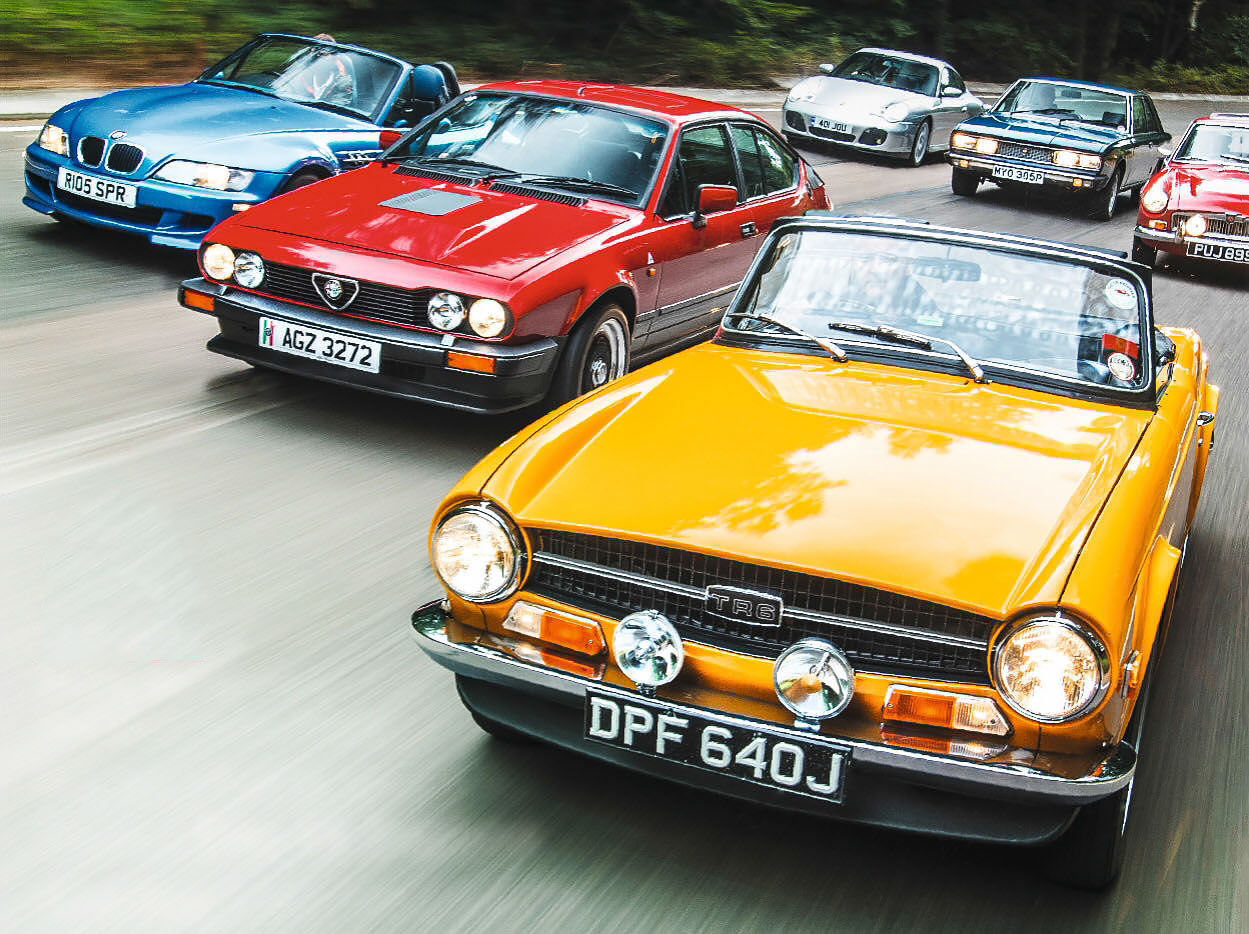
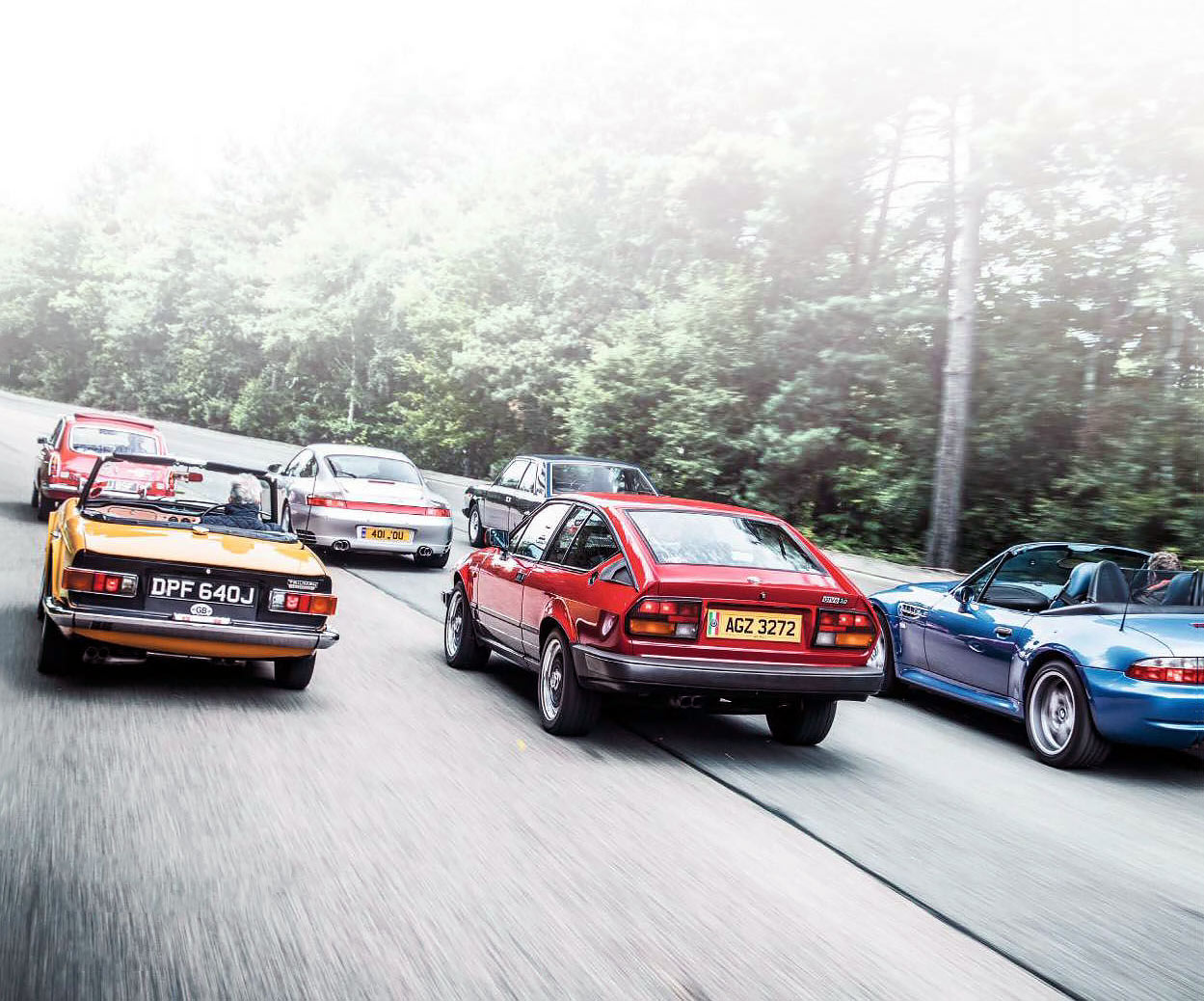
1969 MGC GT
The MGC GT might have sold better in period – and would certainly be seen in a different light today – if British Leyland had distinguished it from the B GT by rather more than a subtle bonnet bulge and slightly wider wheels. Because under that veneer of familiarity beats the heart of a very different car – one that’s more affordable Aston Martin than re-engined MGB. That lack of distinction – and some largely unfounded early bad press – dissuaded many buyers from finding out for themselves and played into the hands of those who wanted to disparage the C for not being the new Austin-Healey. On the other hand it does mean that the MGC has remained an attainable dream – particularly in GT form – for those secure enough in themselves to choose a car based on what they want rather than what others think about it. That remains the case and remarkably you still have to embark on MGC ownership in the knowledge that much of your out-and-about life will involve explaining why your MGB GT has a funny bonnet. Trust me, it’s worth it because BMC’s thorough mechanical revisions transformed the MGB from a pretty but bargain-basement tin-top coupé into an accomplished ground- coverer that fully deserves its GT tag.
The impression of mature cut-aboveness starts with the refined growl of its smooth 2.9-litre straight-six engine. It may have come from the same school as the B’s four-pot but was in the top set and excelled at sports. Some freer breathing and a bit more power might have been preferable, especially when judged by today’s standards, but this was 1967, after all. Jon Glover’s car has enjoyed specialist attention to release some extra power, largely to counteract the rare three-speed automatic’s inherent lethargy. Jon’s is one of just 258 UK cars so-equipped and while it won’t appeal to everyone it suits the car’s cruising nature and the engine’s prodigious torque means I can really make good progress, feeling like I’m driving something rather more special than those familiar looks might suggest.
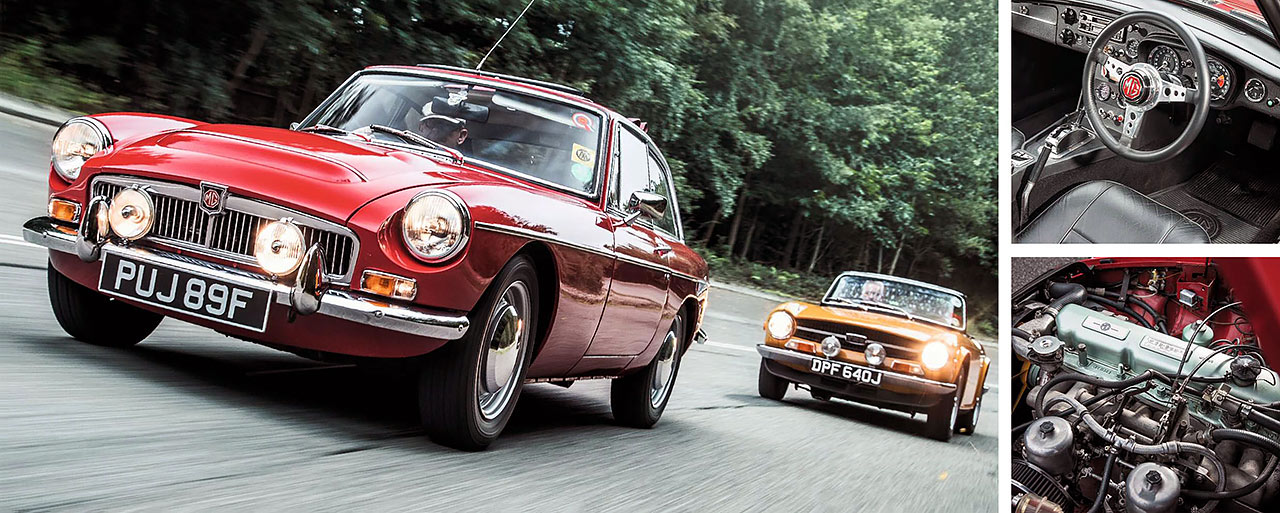
Clockwise from main: bonnet bulge and wider wheels tell you it’s an MGC; just 258 Cs had three-speed auto; 2.9-litre straight six majors on low-down torque.
Anyone used to the MGB suspension’s joggling nature will find the MGC a revelation with its torsion bars rather than coil springs and telescopic instead of lever arm dampers. It glides across surfaces that would rough an MGB up and copes admirably with the extra 90kg of iron bearing down on the front end. These cars may have a reputation for party-spoiling understeer but the reality is a fraction of what those old tales would have you believe. The handling is actually remarkably tight and predictable – especially on modern tyres inflated to the correct pressures – and it only starts to wash out at the front by way of warning when I really push it.
That happens much further up the misbehaviour scale than I was expecting, at which point I’m already having to rely on extra support from the door and centre console because the comfortable seats possess only period levels of lateral support.
Finding a good one is difficult – fewer than 9000 were made and a combination of rust and being too cheap for too long hasn’t helped survival rates – but plenty have been restored, often as a labour of DIY love. Parts back-up is superb, though some parts unique to the MGC – such as front inner wings – are not currently available.
Presentable GTs are available for £9000-£15,000, though dealersupplied show quality cars are nearer £30k. Roadsters are around 50 per cent more expensive than GTs.
‘BMC transformed its bargain-basement tin-top coupé into an accomplished GT cruiser’
Owning an MGC GT
‘I had an MGC Roadster before,’ says Jon Glover – you might remember him as Mr Cholmondley-Warner from Harry Enfield’s Television Programme. ‘Then I bought this GT from Jersey two years ago. It had only done 38,000 miles but needed new sills and a respray. I also had the Webasto roof recovered because it had faded to pink, and fitted a smaller steering wheel because my legs didn’t it under the standard one.
‘The cylinder head has been modified to take unleaded fuel and I got MGC racer Vic Young to fettle the engine and it one of his special exhaust systems to liberate a little more power. Since then it has just needed an annual service, which I have done at The Village Garage in East Grinstead. The chap who runs that is also an MG enthusiast.
‘I’m now doing another MGC Roadster, which is currently just a big pile of bits.’
TECHNICAL DATA 1969 MGC GT
Engine 2912cc inline-six, ohv, two SU 1.75in carburettors
Power and torque 145bhp @ 5250rpm; 170lb ft @ 3400rpm
Transmission Three-speed automatic, rear-wheel drive
Suspension Front: independent by wishbones, torsion bars, telescopic dampers, antiroll bar. Rear: live axle, semi-elliptic leaf springs, lever arm dampers, anti-roll bar
Steering Rack and pinion
Brakes Discs front, drums rear, servo-assisted
Weight 1187kg (2615lb)
Performance Top speed: 118mph; 0-60mph: 10.9sec
Fuel consumption 20mpg
Cost new £1280
Values now £6000-£17,500
{module MG MGB Club}
1970 Triumph TR6
Like the MGC, the Triumph TR6 is powered by a traditional straight-six of charmingly solid low technology. They even produce similar power outputs, though the TR does it with 400cc less and is 64kg lighter. And that’s the main difference between the two – the Triumph instantly comes across as more sprightly, quicker in its responses to driver input and generally more of a sports car. It’s also a great tool for B-road blasts. The TR range was considered to be one of the larger British sports cars in its day so it’s easy to still think of them as being big bruisers today. But times and cars have grown – it’s actually about the same size as a Mazda MX-5 and only marginally heavier.
The trouble with TR6s is that there are plenty of indifferent cars out there that don’t drive anywhere near as well as they should. When buying one you may have to – so to speak – kiss a lot of frogs before you find your prince/princess. It’s an after-effect of too long spent as the most common, least-loved and by a long chalk cheapest of the traditional TRs – many have been run and repaired on beer money. In fact I had a low regard for these cars for over a decade based on those that I’d driven. Then one day a dealer handed me the keys to a superb restored example and two corners down the road I’d completely changed my mind on the subject.
Andrew Smith’s TR6 reminded me of that experience, being an original low-miler that drives exactly as a TR6 should – taut in feel with barely any scuttle shake, grunty in its power delivery and ready to kick its tail out – and back in again – and chirrup its tyres when I shift up to second gear. A TR can do civilised too, but only up to a point. The all-independent suspension soaks up bumps and deals well with changes of direction so I can thread a string of bends together with great pleasure. They are a bit noisy, though – strangely more so with the hood raised – getting one with the optional hardtop is a good idea if you intend to do any long-distance touring.
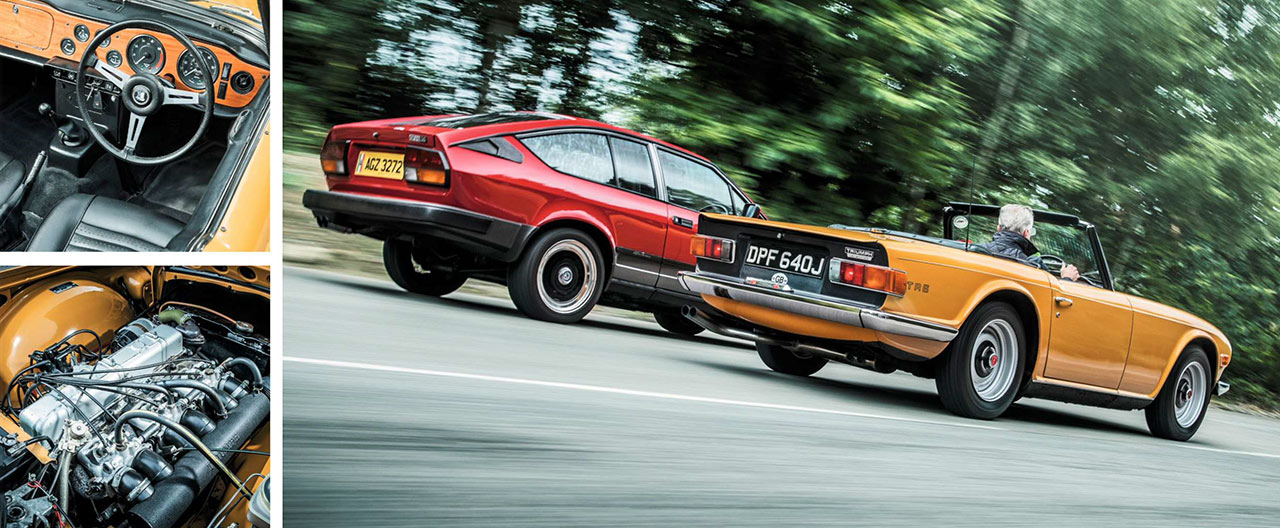
Clockwise from main: styling is essentially a square-edged refresh of the previous TR5; CP-code TR6s have the most powerful engine and are the most desirable; low-slung driving position with offset pedals and steering wheel.
Best of all, the TR6 does all of this easygoing stuff while its archaic driving position connects me to a past era – I’m comfortable, but barely above the floor of the car and find myself peering over the steering wheel with straight legs and bent elbows. The wheel is offset to the left and the pedals to the right but you don’t notice it after a while. The cockpit does the job but it’s no des-res; Triumph appears to have blown its budget on the shapely and nicely finished wooden dashboard, leaving the rest of the interior as a variety of black plastics and cheap carpets. Functional and sporty perhaps, but nothing to get excited about.
There are in effect three variations of TR6, each with significantly different values: 1969-1973 cars whose chassis numbers have a CP prefix are at the top of the tree. These have the full 150bhp (when measured by the old SAE rating – subsequently adjusted to 142bhp during production when manufacturers switched to the DIN measurement system). Middling ones are around £14-£15k but show cars can top £21,000 – and more than that for an original low-mileage example like Andrew’s.
The engine was detuned to 125bhp (DIN) in 1973 to make it smoother and cars with this engine are denoted by a CR chassis number prefix. They’re cheaper – by £2000-£3000 – than CP code cars and so are more likely to be below our £15k budget. Beware of ringers, though – it’s not unknown for cheaper CR cars to be re-registered on CP logbooks. However, genuine CP cars have an opening air vent flap on the scuttle and gauges whose needles pivot from the top rather than the bottom.
Reimported US market cars have low compression engines with twin carburettors rather than fuel injection and are £2000-£3000 cheaper than CRs. Pay no more than £15-£16k for the very best. The best way to distinguish a good TR6 from a bad one – after checking for rust of course – is simply to drive it. Rough ones rattle, shake and feel generally loose in corners.
‘The independent suspension deals well with changes of direction, the better for stringing bends together’
Owning a Triumph TR6
Andrew Smith’s TR6 is an original and unrestored survivor. He says, ‘I’ve owned TR6s since 1982 and got this – my fourth and best – three years ago. It’s only done 45,000 miles with three previous owners. I’ve been in contact with all of them and know all its history. It even has its original sills and hood. The paint is all factory apart from the driver’s door, which was damaged by a supermarket trolley when it was a month old.
‘A previous owner fitted a lot of reproduction parts so I’ve replaced them with refurbished new-old-stock or good secondhand items.
‘TR6s are really easy and cheap to look after – perhaps a couple of hundred pounds a year on servicing and regular rustprooing – and the parts situation is excellent. It does pay to buy a good one in the first place, though.’
TECHNICAL DATA 1970 Triumph TR6
Engine 2495cc inline-six, ohv, Lucas fuel injection
Power and torque 142bhp @ 5500rpm; 164lb ft @ 3000rpm
Transmission Four-speed manual, rear-wheel drive
Suspension Front: independent by wishbones, coil springs, telescopic dampers, antiroll bar. Rear: independent by coil springs, semi-trailing arms and lever arm dampers
Steering Rack and pinion
Brakes Discs front, drums rear, servo-assisted
Weight 1123kg (2473lb)
Performance Top speed: 119mph; 0-60mph: 8.2sec
Fuel consumption 23mpg
Cost new £1401
Values now £8000-£21,000
{module Triumph TR5/6 Club}
1986 Alfa Romeo Alfetta GTV 6
I could try not to bang on too much about the Alfa Romeo GTV 6’s glorious V6 engine but ultimately I’d fail in the attempt because it truly defines the car. The Alfetta GTV was a good car that had won plenty of fans as a road car since its launch in the mid-Seventies and it proved pretty handy in rallies and touring car races in the hands of privateers.
Then Alfa fitted it with the alloy 2.5-litre V6 from the 6 saloon in 1980 and added Bosch fuel injection. The good car was transformed into a great car with a substantial bonnet bulge to clear the engine and distinguish it from the lesser GTV that continued to be sold alongside it.
As well as providing a poky and energetic 160bhp, the V6 has one of the best engine notes this side of a Ferrari V12 – its vocals, which range from rasp to howl, reduce grown adults to adoring teenagers. That said it’s difficult to balance the engine against the clutch – which is either in or out, with little in between – so it needs more revs than feels entirely natural. As a result it’s a lousy town car – it needs to be in its natural habitat, roaming open roads where you can fully exploit all that horsepower.
The steering is typically Alfa Romeo – a perfect mix of smooth precision and constant communication through the slim leather wheel. There’s bags of grip and great balance because the gearbox is in unit with the rear axle. It doesn’t quite eradicate the effect of that big engine up front, though – it understeers more than I was expecting it to when pushed hard.
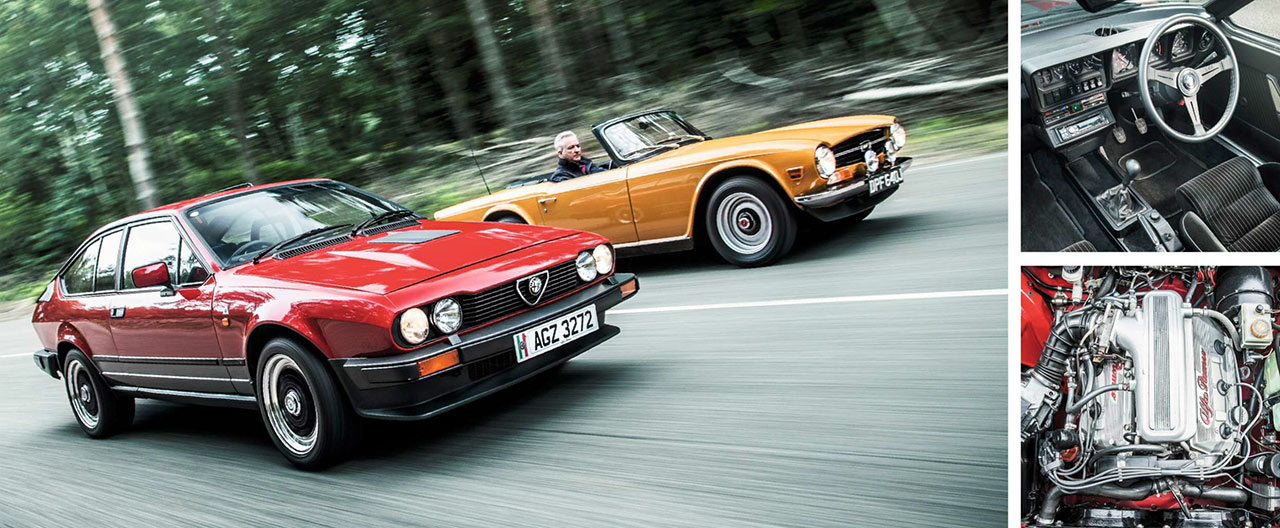
Clockwise, from main: plastic side rubbing strips part of 1983 facelift; rear transaxle means a long-throw gearshift; non-original three-litre V6 delivers an almost Ferrari V12 quality soundtrack.
There’s a price to pay for the distance between the gear lever and the transaxle, too – the throw between gears is very long and there’s a feeling of slackness in the rods and joints that connect them. Some are worse than others but they were criticised for this even when these cars were new. Still, it seems like a small price to pay given how the rest of the car feels.
The brakes are more of a concern. Michael Cotton’s car has uprated anchors but they’re still less than confidence-inspiring – either there’s an inherent fault with this particular example or GTV 6 drivers simply need to adjust their stopping distance forward planning. Still, I’m of a mind to forgive this car anything for the manner in which it gets my adrenaline pumping and the endless joy of that engine note. Even the usual Alfa long-armed driving position isn’t all that noticeable and the pinstriped cloth seats are comfortable and extremely supportive.
So let’s talk about buying one. There are quite a few about, with numbers still being regularly supplemented by South African imports, but rarely many for sale. As such you have to act fast when a car does come up for sale because good ones often sell quickly and usually for the asking price.
Marque expert Alex Jupe warns against buying cheap-looking cars with recent paint jobs that often hide a multitude of rust-related sins and says the most worrying areas in which to find rot are the scuttle panel below the windscreen, the bulkhead directly beneath that and the inner wings. In fact rust is so common in the latter in particular that you are more likely to be judging the quality – or otherwise – of past repairs than admiring perfect metal.
Growing interest in GTV 6s means that prices have risen steadily in the last two years. The top-end cars you could have bought for £15k back then are nearer £20k now and you’ll find little that’s worth bothering with for less than £10,000. There are projects out there to be had for around £5000 – if you’re feeling brave – but rust issues can quickly turn a restoration into a money-pit.
Quite a few cars have, like ours, been fitted with a three-litre V6 from other models in the Alfa range. This is a generally accepted modification that doesn’t adversely affect values until you get up to originality-obsessed concours levels. Pre-1983 facelift models lack later cars’ plastic side rubbing strips and are highly sought-after as a result, but they’re a lot harder to find.
‘The steering is a perfect mix of smooth precision and constant communication through the wheel’
Owning an Alfa Romeo GTV 6
Alfa addict Michael Cotton says, ‘I have a 147 for daily use and a 1600 GT Junior trackday car. I bought this GTV6 in February this year from Alex Jupe Motorsport which had restored it three years previously. It had bills totalling £30,000; I paid half that.
‘The brakes were hopeless compared to the performance – it has the three-litre V6 – so I’ve fitted vented discs and uprated pads. Its Revolution alloys also had to go – I got reproductions of the wheels fitted to the South African 3.0. ‘I’ve had no other costs – I’ve only done 400 miles in it so far. It lives in a Carcoon and never gets wet. I bought it with an inheritance instead of topping up my pension pot – prices of these cars are on the up so this will hopefully earn me more than that and be huge fun in the meantime.’
TECHNICAL DATA 1986 Alfa Romeo Alfetta GTV 6
Engine 2492cc V6, ohc per cyl, Bosch L-Jetronic fuel injection
Power and torque 160bhp @ 6000rpm; 157lb ft @ 4000rpm
Transmission Five-speed manual, rear-wheel drive
Suspension Front: independent by wishbones, torsion bars, telescopic dampers and anti-roll bar. Rear: De Dion axle, coil springs, Watt linkage, telescopic dampers, anti-roll bar
Steering Rack and pinion
Brakes Vented discs front, discs rear, servo-assisted
Weight 1227kg (2702lb)
Performance Top speed: 132mph; 0-60mph: 8.8sec
Fuel consumption 26mpg
Cost new £11,320
Values now £4500- £16,500
{module Alfa Romeo Alfetta GTV Club}
1975 Fiat 130 Coupé
The Fiat 130 Coupé is a great car with a split personality. Such is its air of brooding menace that it almost doesn’t matter how it drives. The headlamps almost seem to follow me when I walk past it and I can’t help whistling the theme to The Godfather when I drive it.
I’m fortunate enough to be tasked with driving Jonathan Hackford’s superb right-hand drive example to the test track for our photo shoot and the word that keeps springing to mind as it happily mixes it with M25 traffic is ‘smooth’. Everything about it – from the manner of its power delivery to the power steering and the action of the controls – fits that description. The cabin is quiet too apart from the rare occasions when I venture above 70mph, at which point the old period blight of wind noise starts to intrude. The 130 proves to be so good in this role in fact that I start to worry that it might be nothing more than a very fine cruiser.
Then I open it up on the test track’s twisty middle section and discover a wholly different side to the Fiat’s personality. Someone plugs its microphone in and the engine starts to sing before delivering some genuine get-up-and-go. Cornering is an absolute scream – the body rolls like a dinghy on the English Channel but the well-sorted all-independent-sprung chassis soaks it up effortlessly and it just grips and grips without the slightest hint of protest from the tyres. I’m sure it must look hugely dramatic from the outside but I feel in complete control at all times.
Where the 130 does fall down is in its stopping power. The brakes feel fine in normal driving but are prone to fade when used hard – I use the same braking point in all of our assembled cars and the Fiat is the only one that almost sails straight past the exit point. But then again, you aren’t going to buy a Fiat 130 to use as a trackday car.
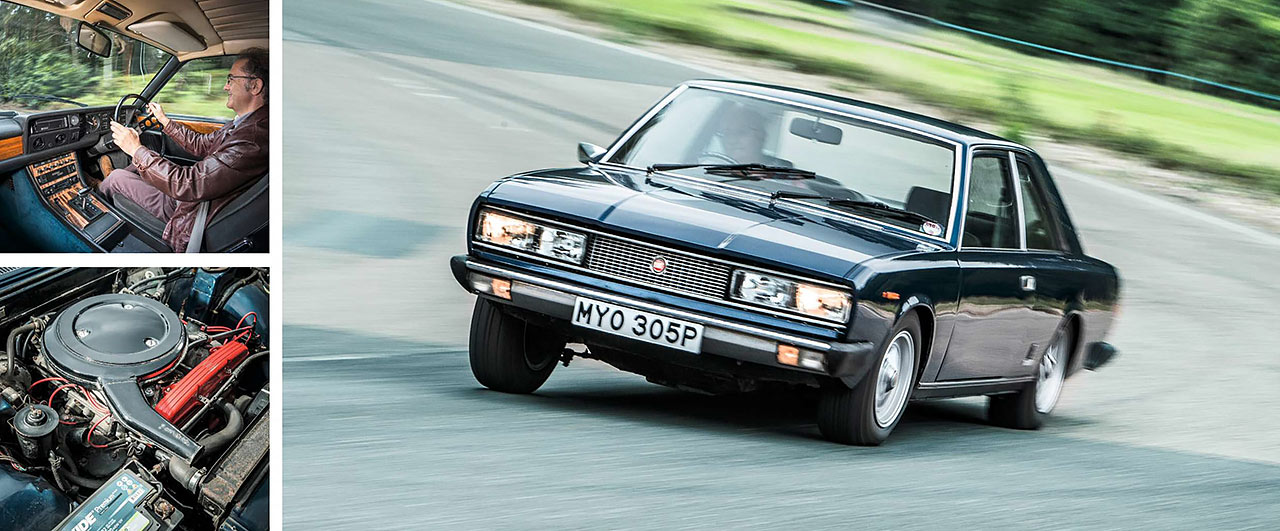
Clockwise, from main: soft suspension but plenty of grip; 3.2-litre V6 delivers smooth, sonorous power; Seventies interior with music centre wood and stylish steering wheel.
All this from a cabin that has plenty of what passed for decadence in Seventies Italy – music centre-style wood veneers for the dashboard, door tops and centre console, a cubist instrument binnacle and the surprise of velour cloth seats rather than leather; a surprise because they are of such plush high quality that I wouldn’t want the leather alternative. Then there’s the steering wheel, so gloriously of its time in hard plastic with two fat spokes, each decorated with three large holes. Put that way it should look and feel cheap but frankly belongs in a design museum.
The styling is straight out of Pininfarina’s brief straight lines period, which also gave us the Rolls-Royce Camargue and Ferrari 400 series. The Ferrari in particular featured in some debate among our gathered owners on the day, the consensus being that the 130 really ought to be wearing a Ferrari badge because it’s better looking than any of the Prancing Horse’s 2+2 models.
The 130 Coupé has moved up the price tables recently, with the best examples starting to top £20k, but you can also find driver quality cars for under £10,000. But you’ll probably have to settle for left-hand drive, because right-hookers are getting very rare. At the time of writing there are five 130 Coupés advertised in the UK, only one of which is right-hand drive, but there’s a regular trade in shipping 130s over from Italy where they are worth considerably less than they are over here. Now there’s an idea for an adventure holiday… Wherever you shop, finding one with a manual gearbox would be a genuine red-letter day because most were equipped with a three-speed Borg-Warner automatic. This isn’t necessarily a bad thing, though; a self-shifter suits the car’s laid-back character and you also have to expect to pay some kind of price premium for a car with a manual gearbox.
Aside from wanting to see bills for regular specialist attention to the V6 engine, buying a good 130 comes down to the usual Italian adage of buying a good body and worrying about the rest later. Fiat made just 4491 of them so any body repairs will probably have to be handmade, and they can rust just about everywhere.
‘Cornering the 130 is a scream – it rolls, but grips and grips without the slightest hint of protest from the tyres’
Owning a Fiat 130 Coupé
‘I always loved the 130 when I was growing up in the Seventies,’ says Jonathan Hackford. ‘Then after seeing a story about one in the March 2014 issue of Classic Cars I decided it was time I owned one. I heard about one that pretty much fitted my criteria and took an expert friend with me to assess it. We could only find two tiny bits of rust on the whole car, so I bought it.
‘I took it to Colin Clarke Engineering which serviced it, went through the engine, refurbished the wheels and then Colin tried to buy it! Since then I’ve had the gearbox overhauled, the fuel lines replaced and the tank refurbished. I replaced the low profile tyres with the correct profile so it now rides a lot better yet corners just as well. I’ve had no other problems – I just don’t get to drive it enough.’
TECHNICAL DATA 1975 Fiat 130 Coupé
Engine 3235cc V6, ohc per cyl, Weber 45 DFC twin-choke Carburetor
Power and torque 165bhp @ 5600rpm; 184lb ft@ 3400rpm
Transmission Five-speed manual or three-speed auto, rear-wheel drive
Suspension Front: independent by MacPherson struts, lower arms, torsion bars, anti-roll bar. Rear: independent, struts, coil springs, lateral locating arms, anti-roll bar
Steering Worm and roller, power-assisted
Brakes Discs front and rear, servoassisted
Weight 1555kg (3428lb)
Performance Top speed: 118mph; 0-60mph: 10.6sec
Fuel consumption 18mpg
Cost new £8201
Values now £7000-£17,500
{module Fiat 130}
2004 Porsche 911 (996) C4S
The 996 C4S incarnation of the Porsche 911 is too good, too competent. Can that be a criticism? For anyone who shares my pre-millennial motoring tastes, the 996 is going to feel like a new car, largely because most new cars are still using most of the technology Porsche threw at its scratch-built new dawn of water-cooled 911s.
That change was largely driven by a need to reduce the engine noise inherent with aircooled motors in order to meet ever-stricter legislation. The result is a 911 with a very different character to all that went before; it’s subdued and civilised – you’re no longer being chased by a chainsaw. That – and some reputational issues we’ll come to – may explain why the 996 is currently the most affordable of all 911s. Marque enthusiasts have been reluctant to embrace them and are happy to pay twice as much for one of its 993 predecessors.
Lack of noise aside – though you could always fit a sports exhaust – the 996 does at least still feel like a 911 from the driver’s seat, which itself will feel familiar to anyone who has previously parked their backside in a Porsche. The driving position is spot on, the view out is reassuring and all the controls have that well-honed Porsche feel to them. The power delivery feels effortless, the performance easy to access. It has similar numbers to the BMW on paper but the Porsche somehow feels quicker and even better planted. The C4S’s fourwheel drive system just clings on, even if I take the sort of liberties that would have constituted a health and safety issue in an earlier 911. I put this to the test when a rain shower punctuates my test drive, but it makes no difference to how the Porsche behaves. The brakes are the only real dynamic disappointment – they do the job but feel less effective than I was expecting, especially after driving the Z3M. I’m impressed, just not excited.

Clockwise, from main: C4S rear bodywork is wider than a regular 911’s; 996 sacrificed some tactility for huge capability; cylinder bore and cylinder head woes are rare on post-2002 3.6s.
That established, we must address the elephant in the 996’s room – its reputation for lunching engines. There are two particular flaws, though they don’t affect all 996s and Russ Stanley of Revolution Porsche says they have been rather blown out of proportion by online forums. There can be an issue with the intermediate shaft (IMS) bearing losing its supposedly sealed for life lubricant, breaking up and wrecking the engine. But hard facts show that this affects fewer than one in ten engines. So you can either take a chance or eliminate the problem completely by having a ceramic dual-row IMS bearing fitted at a cost of £1200-£1300.
Engines about to suffer IMS bearing failure often make a loud rattling noise on start-up that disappears after about ten seconds. It’s better to find a car that’s already had the bearing replaced – at the time of writing we’re eyeing up an internet advert for a very smart blue Carrera 2 with factory Sport Pack and recent ceramic IMS bearing and new clutch being offered for just £14,950.
The other issue is with cracks in the cylinder bores or cylinder heads, though again it’s about a one in ten incidence rate. The best way to avoid buying an affected car is to pay a Porsche specialist a couple of hundred pounds to carry out an endoscope inspection – a fraction of the cost of rebuilding or replacing the engine. It’s also worth remembering that the problem mainly affects the earlier 3.4 engine and is rare in 2002-on 3.6s.
Prices for presentable 3.4s start at under £10,000, though you’ll probably need to spend more than £12k to secure one of the 3.6s; 996s may still be just used cars to much of the market, but the 3.6s are that much newer and more desirable. The S designation adds a little value, as does four-wheel drive as in this C4S, but there’s no premium for convertibles because there are lots about and driving enthusiasts prefer the hardtops.
Either way it’s not a purchase you need to rush. Porsche built about 175,000 996s, so you don’t have to worry about rejecting any cars that don’t tick all the boxes for specification and history; there will always be others to look at.
‘The 911 has similar numbers to the BMW Z3M on paper but feels somehow quicker and even better planted’
Owning a Porsche 996
‘I bought it two-and-a-half years ago to replace a Boxster 2.7,’ says Andrew Gribben. ‘It only had 23,000 on the clock, but is up to 32,000 now, much of that from driving across France twice.
‘I replaced the original tyres – which had started to crack – and the rusty front brake discs. I also had to get the radiators replaced but thankfully that was done under warranty, otherwise it would have cost £1500. They rot out because of all the muck that accumulates around them, so now I clean them out every year.
‘Other than that, it’s been surprisingly cheap to run. It only needs servicing every two years – and that’s £400 for a major service and £295 for a minor one.’
TECHNICAL DATA 2004 Porsche 911 (996) C4S
Engine 3596cc flat-six, dohc per bank, Bosch Motronic M sequential fuel injection, water-cooled
Power and torque 320bhp @ 6800rpm; 273lb ft @ 4250rpm
Transmission Six-speed manual, four-wheel drive
Suspension Front: independent by MacPherson struts, lower wishbones, coil springs, anti-roll bar. Rear: independent by five wishbones, coil springs, telescopic dampers, anti-roll bar
Steering Rack and pinion
Brakes Vented and drilled discs front and rear, servo-assisted
Weight 1470kg (3237lb)
Performance Top speed: 174mph; 0-60mph: 5.0sec
Fuel consumption 25mpg
Cost new £63,630
Values now £9000-£29,000
{module Porsche 996}
1998 BMW Z3M Roadster E36/7
The chance to drive a BMW Z3M Roadster fascinated me because there’s one of its less talented 2.8-litre relatives in the Smith family fleet. Entertaining enough to drive but I’m well aware of its foibles. What would an additional 129bhp do to a chassis that already feels quite challenged? The answer is that you should never underestimate an M badge on a BMW. The Z3M’s chassis modifications cope admirably with the stresses and strains of 321bhp and it actually feels safer and better glued to the road than the 2.8.
That takes some clever engineering because there appears to be no pay-off in compromised ride comfort. The Z3M suffers none of the 2.8’s bump-steer or camber change dramatics and there’s a lot less body roll too. The harder I push the M, the more I like it. What’s particularly impressive is how it follows any tight cornering line I point it at; it just grips and goes, leaving me breathless with the G-forces it can generate. It handles well too, responding instantly to steering inputs without upsetting its composure. The brakes – from the M3 saloon – are also beyond reproach.
But however impressive all that is, the chrome cherry on the Z3M’s cupcake is its engine, a technical marvel that’s a member of the exclusive 100bhp-per-litre club. At the time it meant the Z3M Roadster was the quickest ever BMW from 0-60mph, pipping the heavier coupé version. Its Double-VANOS system (VANOS is an unpronounceable German acronym meaning variable camshaft timing) is particularly clever and constantly adjusts the position of both camshafts hydraulically to give a vast and flexible spread of usable power, from thumping torque at 2000rpm to a rev- happy upper range that doesn’t peak until a Honda S2000-baiting 7400rpm. Optimising its output in this way also means that it’s surprisingly economical, averaging consumption in the mid-20s. The result of all this is the perfect dual-purpose sports car that’s as at home pottering through town as it is hurtling round a track.
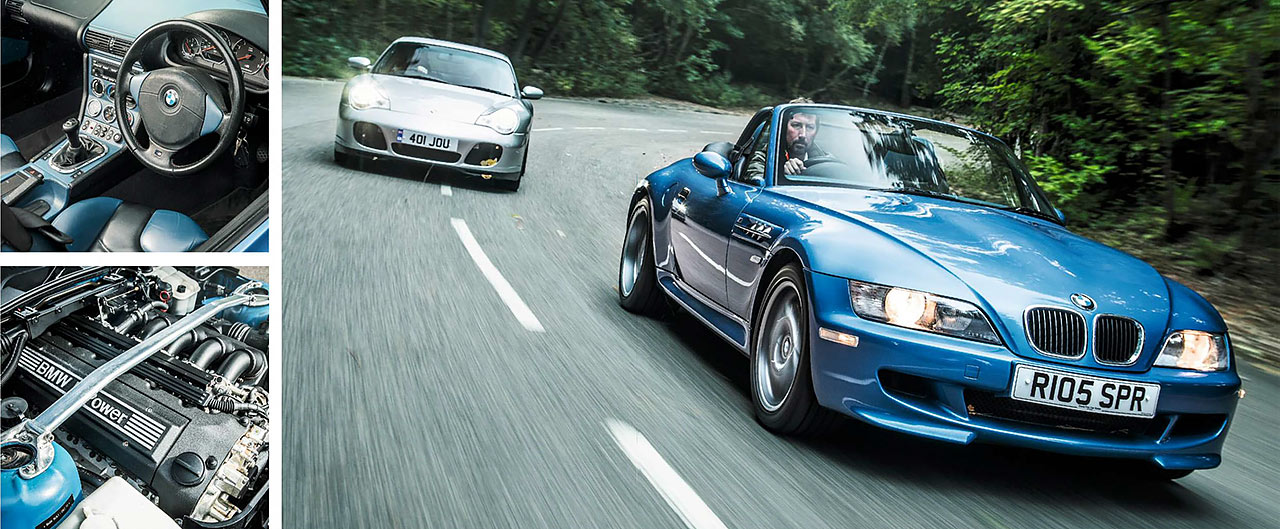
Clockwise, from main: Roadster was once BMW’s fastest-ever car from 0-60mph; 3.2-litre engine revs to 7400rpm; variable ratio steering response is instantaneous.
They do have their faults; the seats in Tony Godwin’s car have the classic issue of rocking back and forth under acceleration and braking but that’s just £12 for bushes and an morning’s work to fix. The power hood often converts itself to manual, which means either getting out of your seat to close it or spending hundreds of pounds chasing the fault around failed microswitches, wiring or the pump motor. Buyers should always check the boot floor too – all that power being fed through the rear axle mounts can pop the spot- welds, affecting axle location and leading to further damage.
The VANOS system can fail and repairs can run to over £3000. Poor low-end torque and a whirring, grating noise from the front of the engine suggest imminent problems, though you don’t want to see oil leaks from it, either – even replacing the VANOS gasket can top £200. Good BMW or specialist service history is a must.
Most Z3M attention to date has focused on the coupé model. It already has a cult following that has nudged prices towards the £30k mark. As such the Z3M is one of very few models where the hardtop – whose unusual styling is considered by many to be rather awkward – is worth more than the open version, something that is very much to the advantage of Roadster buyers. However Roadster prices are beginning to creep higher with 30,000-40,000-mile cars being offered by dealers for around £24,000. But there are plenty of slightly higher-mileage cars available for under £20k. The good news is that you can still find something with five-figure mileage and full service history below our budget.
BMW seems to have protected the Z3M extremely well against corrosion but buyers should still check for consistent panel gaps and behind panels in the engine bay and boot area for evidence of previous accident damage repairs – overspray and damaged or missing factory stickers are good indicators that a car has been involved in a shunt at some point in its life.
‘It follows any tight cornering line I point it at – it just grips and goes, leaving me breathless with the G-forces it generates’
Owning a BMW Z3M Roadster E36/7
Tony Godwin has owned his Z3M for four years, ‘I bought it for some summer fun. I liked the idea of an older classic, but not the worry of it breaking down and the need for constant maintenance, so I started looking at Z3Ms and early Audi TTs.
‘This car came up at a good price, though it was up in Yorkshire and I had a long cautious drive home to Oxfordshire in pouring rain.
‘I have annual services carried out by an independent BMW specialist for about £250-£400 and have replaced brake pads and track rod ends.
‘It can be a bit of a handful – half of them have already gone according to howmanyleft.com.’
TECHNICAL DATA 1998 BMW Z3M Roadster E36/7
Engine 3201cc inline-six, dohc, Double-VANOS variable valve timing, MSS 50 engine management
Power and torque 321bhp @ 7400rpm; 258lb ft @ 3250rpm
Transmission Five-speed manual, rear-wheel drive
Suspension Front: independent by MacPherson struts, lower L-arms, anti-roll bar. Rear: independent with coil springs, semi-trailing arms, telescopic dampers, anti-roll Bar
Steering Variable ratio rack and pinion, power-assisted
Brakes Vented discs front and rear, servo-assisted
Weight 1350kg (2976lb)
Performance Top speed: 155mph (limited); 0-60mph: 5.2sec
Fuel consumption 25mpg
Cost new £40,500
Values now £10,000-£20,000
{module bmw Z3}
Verdict
I really like the idea of a bargain 911 and would have no qualms about getting a 996’s engine inspected and its IMS bearing replaced. Do these relatively straightforward jobs and they can go on for ever. In fact I’d happily use one every day, something many owners do already. But as a weekend toy the 996 just doesn’t tug my heartstrings hard enough.
To my great surprise I have a similar issue with the GTV 6. I’m a big Alfa Romeo fan and love the noise it makes and the way it drives, but something about it just doesn’t quite gel for me. And the inescapable bottom line is that there is no way I would ever swap my ’1972 Spider for one.
The British pair have a lot going for them and I’d happily have a nice example of either because they offer the right kind of classic driving experience. The TR would have to be in the right sort of colour, though – preferably something properly bright and Seventies. Which leaves the final decision as a straight fight between the Fiat 130 Coupé and BMW Z3M Roadster, and obviously I’m going to choose the Italian over the German. Except this time I’m not. I’m as beguiled by the Fiat as I am slightly unnerved by the prospect of owning one but it has been beaten – if only by the smallest of margins – on this occasion. BMWs – even M cars – don’t usually excite me all that much but I really enjoyed the Z3M and know I could quickly form a fun relationship with one, especially if I could get one before prices start to spiral out of reach.
Thanks to: MG Car Club, Triumph TR Register, Fiat Motor Club, Alfa Romeo Owners’ Club, zroadster.net, Porsche Club GB, Gavin Bushby
‘I’m beguiled by the Fiat, but it is beaten – if only by the tiniest of margins – on this occasion’
Quentin Willson’s choice
Tough one this. The MGC is a great cruiser, much underrated and definitely moving up in value. I’m not entirely sure that £15k would buy a really lovely one, though – and I’d always be distracted by an MGB GT V8 for similar money. The TR6 is lusty and a riot in the wet but it’s looking a wee bit clichéd now. There are lots about too so its not distinctive enough for me.
The Alfa GTV 6 is rare and special but too labourintensive; you’d be fiddling and fettling daily to keep it looking and running right. I don’t think it has much more appreciating to do, either.
The BMW Z3M is a hard-charging warrior but too numerous and commonplace to keep me interested so I’m torn between the Porsche and the Fiat. A £15k 911 would feel irresistible if it weren’t for the 996’s reputation for intermediate shaft bearing failure and cylinder bore cracks. I’ve seen too many that need engine rebuilds after relatively few miles. So that leaves the slinky Fiat 130 Coupé. Gorgeous, practical and rare, it’s still a monster bargain. In August Historics at Brooklands sold a silver left-hand-drive ’1978 manual with just 36,000km for £8680. If I’d been there I would have joyfully driven it home.
Each of these sixes has a soundtrack to die for, but only one of them is a genuinely talented all-rounder.
{CONTENTPOLL [“id”: 88]}





